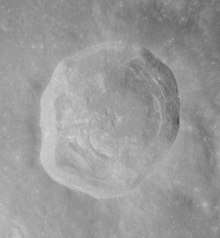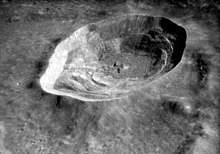Lalande (crater)
Lalande is a small lunar impact crater that lies in the central part of the visible Moon, on the eastern edge of Mare Insularum. It was named after French astronomer Jérôme Lalande.[1] The crater is surrounded by a high-albedo area of ejecta that extends into a ray system with a maximum radius of over 300 kilometers. The interior wall has a terrace system, and there is a small central rise at the midpoint of the floor. It was formed during the Copernican period of the moon extending from 1.1 billion years ago to the present. Its young age is indicated by the bright rays of ejecta surrounding the crater, its sharp features, and the relative lack of later impacts in its interior.[2] The rays of ejecta from Lalande overlay the ejecta rays from Copernicus Crater, meaning it is younger than Copernicus, and thus no more than 800 million years old.[3]
 Apollo 12 image | |
| Coordinates | 4.4°S 8.6°W |
|---|---|
| Diameter | 24 km |
| Depth | 2.6 km |
| Colongitude | 9° at sunrise |
| Eponym | Jérôme Lalande |

In 2002, a meteorite was discovered in the Oman desert by Edwin Gnos of the University of Berne. This rock, identified as Sayh al Uhaymir 169, is believed to have originated from the Moon. It was ejected from the surface during an impact that occurred less than 340,000 years in the past. Scientists now think that the rock originated from the crater ejecta blanket surrounding Lalande.[4]
Satellite craters
By convention these features are identified on lunar maps by placing the letter on the side of the crater midpoint that is closest to Lalande.
| Lalande | Latitude | Longitude | Diameter |
|---|---|---|---|
| A | 6.6° S | 9.8° W | 13 km |
| B | 3.1° S | 9.0° W | 8 km |
| C | 5.6° S | 6.9° W | 11 km |
| D | 6.1° S | 7.5° W | 8 km |
| E | 3.4° S | 10.7° W | 4 km |
| F | 2.6° S | 10.0° W | 3 km |
| G | 6.2° S | 7.9° W | 5 km |
| N | 5.6° S | 5.7° W | 6 km |
| R | 4.7° S | 7.0° W | 24 km |
| T | 5.2° S | 7.5° W | 4 km |
| U | 3.2° S | 8.1° W | 4 km |
| W | 6.5° S | 5.6° W | 11 km |
References
- "Lalande (crater)". Gazetteer of Planetary Nomenclature. USGS Astrogeology Research Program.
- Li et al., Geological Mapping of Lunar Crater Lalande: Topographic Configuration, Morphology and Cratering Process
- Apollo 14 Preliminary Science Report
- Gnos, Edwin, et al., 2004, Pinpointing the Source of a Lunar Meteorite: Implications for the Evolution of the Moon, Science 30 July 2004: Vol. 305 no. 5684 pp. 657-659 DOI: 10.1126/science.1099397 abstract
- Andersson, L. E.; Whitaker, E. A. (1982). NASA Catalogue of Lunar Nomenclature. NASA RP-1097.CS1 maint: ref=harv (link)
- Bussey, B.; Spudis, P. (2004). The Clementine Atlas of the Moon. New York: Cambridge University Press. ISBN 978-0-521-81528-4.CS1 maint: ref=harv (link)
- Cocks, Elijah E.; Cocks, Josiah C. (1995). Who's Who on the Moon: A Biographical Dictionary of Lunar Nomenclature. Tudor Publishers. ISBN 978-0-936389-27-1.CS1 maint: ref=harv (link)
- McDowell, Jonathan (July 15, 2007). "Lunar Nomenclature". Jonathan's Space Report. Retrieved 2007-10-24.CS1 maint: ref=harv (link)
- Menzel, D. H.; Minnaert, M.; Levin, B.; Dollfus, A.; Bell, B. (1971). "Report on Lunar Nomenclature by the Working Group of Commission 17 of the IAU". Space Science Reviews. 12 (2): 136–186. Bibcode:1971SSRv...12..136M. doi:10.1007/BF00171763.CS1 maint: ref=harv (link)
- Moore, Patrick (2001). On the Moon. Sterling Publishing Co. ISBN 978-0-304-35469-6.CS1 maint: ref=harv (link)
- Price, Fred W. (1988). The Moon Observer's Handbook. Cambridge University Press. ISBN 978-0-521-33500-3.CS1 maint: ref=harv (link)
- Rükl, Antonín (1990). Atlas of the Moon. Kalmbach Books. ISBN 978-0-913135-17-4.CS1 maint: ref=harv (link)
- Webb, Rev. T. W. (1962). Celestial Objects for Common Telescopes (6th revised ed.). Dover. ISBN 978-0-486-20917-3.CS1 maint: ref=harv (link)
- Whitaker, Ewen A. (1999). Mapping and Naming the Moon. Cambridge University Press. ISBN 978-0-521-62248-6.CS1 maint: ref=harv (link)
- Wlasuk, Peter T. (2000). Observing the Moon. Springer. ISBN 978-1-85233-193-1.CS1 maint: ref=harv (link)
External links
| Wikimedia Commons has media related to Lalande (crater). |
- Rock traced from moon crater to Earth — CNN article from July 30, 2004 (accessed 10/06/05.)
- Images of Lalande crater at LPI moon atlas
- Lalande at The Moon Wiki